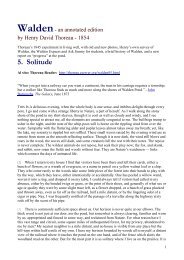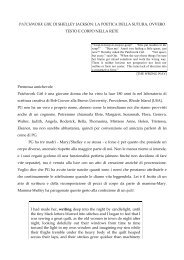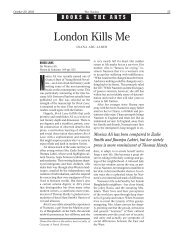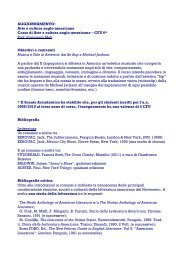Rewriting Woolf s Mrs. Dalloway: Homage, Sexual ... - Paola Carbone
Rewriting Woolf s Mrs. Dalloway: Homage, Sexual ... - Paola Carbone
Rewriting Woolf s Mrs. Dalloway: Homage, Sexual ... - Paola Carbone
Create successful ePaper yourself
Turn your PDF publications into a flip-book with our unique Google optimized e-Paper software.
it will be returned. By delivering a many-mirrored variation on a significant<strong>Woolf</strong>ian moment, Cunningham not only riffs on the precursive author's text butalso universalizes the ambiguity of sexual identity and desire. Whereas in <strong>Mrs</strong>.<strong>Dalloway</strong> one woman shares a single kiss with another woman, in The Hoursmyriad characters of varied sexual orientation (straight, queer, bi) experience adesire to kiss someone they are not supposed to kiss.In novels that foreground the ambiguity of sexual orientation, the instabilityand complexity of identity is often prominent, which is true in both <strong>Woolf</strong>'s andCunningham's novels. As <strong>Woolf</strong> critics have pointed out, Clarissa's identity isneither fixed nor absolute: "Clarissa <strong>Dalloway</strong> is seen as an individual whoseidentity varies according to the situation in which she finds herself; at differenttimes, and with different people, she appears to be a different person" (Hawthorn9). Cunningham follows <strong>Woolf</strong> in that each of his three central female figures—Virginia <strong>Woolf</strong>, Laura Brown, and Clarissa Vaughan—possesses various or alternativeselves. In this brief exchange between Virginia <strong>Woolf</strong> and her servantNelly, Cunningham alerts us to the ways in which performance and impersonationfigure in mundane activities:Virginia walks through the door. She feels fully in command of the characterwho is Virginia <strong>Woolf</strong>, and as that character she removes her cloak,hangs it up, and goes downstairs to the kitchen to speak to Nelly about lunch.In the kitchen, Nelly is rolling out a crust. Nelly is herself, always herself;[. . .]. How does she rememher, how does she manage, every day andevery hour, to he so exactly the same? (84)That the self is fragmented and unstable, comprising multiple selves, is furtherenhanced in The Hours by the fact that these three women, whose lives echo oneanother, can be viewed as "identities-in-relation," aspects of a collective femaleself, three versions of a twentieth-century woman. In addition, given that each ofthese women desires to touch or kiss someone whose gender is not that to whichthey are usually drawn, Cunningham universalizes the human desire for contactthat transgresses narrowly defined labels of gender orientation. Again, it is as ifCunningham has brought various mirrors to his text, in this case extending andimprovising on <strong>Woolf</strong>'s exploration of the fragmentation, complexity, and multiplenature of the self.Some may argue that Cunningham's novel relies excessively on imitation andis an exploitation of <strong>Woolf</strong>'s literary innovations, but Oscar Wilde reminds us, "Itis only the unimaginative who ever invents. The true artist is known by the usehe makes of what he annexes, and he annexes everything."^ Just as Hemingwayborrowed from Gertrude Stein, or more recently as Jonathan Franzen has borrowedfrom Don DeLillo, Cunningham annexes the style, structure, characters,and vision of <strong>Woolf</strong>. Yet, his novel is neither clonelike nor hollow; rather, it is anexhilarating enhancement that, in turn, has greatly expanded Cunningham'srange and abilities as a novelist.SUMMER 2004, VOL. 45, NO. 4 371








